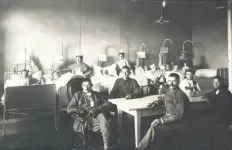1918 pandemic second wave had fatal consequences
2021-02-09
(Press-News.org) In the event of a pandemic, delayed reactions and a decentralized approach by the authorities at the start of a follow-up wave can lead to longer-lasting, more severe and more fatal consequences, researchers from the universities of Zurich and Toronto have found. The interdisciplinary team compared the Spanish flu of 1918 and 1919 in the Canton of Bern with the coronavirus pandemic of 2020.
The Spanish flu was the greatest demographic catastrophe in Switzerland's recent history, causing approximately 25,000 deaths in the country during 1918 and 1919. In the wake of the current coronavirus pandemic, there has been increased public and scientific interest in the events of that time. An interdisciplinary team of researchers in evolutionary medicine, history, geography and epidemiology from the universities of Zurich and Toronto has spent several years analyzing historical data on the spread of influenza-like illnesses during 1918 and 1919 in the Canton of Bern. The canton is ideally suited as a Swiss case study, because it is large and has a diverse landscape, it was hit particularly hard by the Spanish flu, and right at the start of the pandemic in July 1918 it introduced an obligation to report cases.
Public health measures effective in the first wave
The results of the new study show that the spread of Spanish flu differed depending on the region. In the first wave in July and August 1918, the Canton of Bern intervened relatively quickly, strongly and centrally, including by restricting gatherings and closing schools. "We see from the numbers that these measures - similar to today - were associated with a decrease in infection numbers," says co-first author Kaspar Staub of the Institute of Evolutionary Medicine at the University of Zurich. After the first wave had subsided, the canton lifted all measures entirely in September 1918, which led to a rapid resurgence of cases and the onset of a second wave after only a short time.
Delayed action at start of second wave was fatal
At the beginning of the second wave in October 1918, the Canton of Bern reacted hesitantly, unlike in the first wave. Fearing renewed economic consequences, the cantonal authorities left responsibility for new measures up to the individual municipalities for several weeks. "This hesitant and decentralized approach was fatal and contributed to the fact that the second wave became all the stronger and lasted longer," says co-first author Peter Jueni of the University of Toronto.
In addition, shortly after the peak of the second wave in November 2018, there was a national strike with demonstrations on social and labor issues and, most importantly, larger troop deployments. These mass gatherings, as well as a subsequent relaxation of the ban on gatherings when the number of cases was still far too high, were accompanied by a significant resurgence in infections. Ultimately, about 80 percent of the reported illnesses and deaths were attributable to the second wave.
History repeats itself in 2020
By comparing the weekly case counts of the Spanish flu and coronavirus, the researchers found that the second wave started in almost the same calendar week in both 1918 and 2020, and the official delayed response was similar. "While there are still considerable differences between the two pandemics, the steadily increasing parallels between 1918 and 2020 are remarkable," Staub says. The study also shows that empirical knowledge from past pandemics - for example, on the challenges and how to deal with follow-up waves - is available. "Since November 2020, deaths from Covid-19 have far exceeded those caused by cancer or cardiovascular disease and for around three months it has been the most common cause of death in Switzerland. In view of the high death rate during the second wave in comparison with other countries, and with the threat of a third wave due to virus mutations from England, South Africa and Brazil, lessons from the past could help the authorities and the public to rethink their response," adds Jueni.
Historical archive data with relevance for the present day
The study was based on records in the Bern State Archives of cases of influenza-like illness by municipality and region, as reported weekly by doctors to the cantonal authorities. "These records are a real treasure trove and a great example of how data that is more than 100 years old can be relevant today," Staub says. Back in 2015, the research team began transcribing the more than 9,000 medical reports with over 120,000 influenza cases from 473 Bernese municipalities between June 1918 and June 1919. They then analyzed the data using modern epidemiological methods and reconstructed the measures taken at cantonal level to prevent the spread of the pandemic to create an overall picture.
INFORMATION:
[Attachments] See images for this press release:

ELSE PRESS RELEASES FROM THIS DATE:
2021-02-09
Oakland, Calif. -- An analysis of Kaiser Permanente members in Northern California early in the COVID-19 pandemic found racial and ethnic disparities in the likelihood of testing positive for the coronavirus, but no significant disparities in mortality among those who were hospitalized.
According to the study published Feb. 8 in Annals of Internal Medicine, Latino patients were nearly 4 times as likely as white patients to become infected with the virus, while Asian and Black patients were 2 times as likely to get COVID-19 as white patients. The odds of hospitalization were also higher for Latino, Asian, and Black patients with ...
2021-02-08
PITTSBURGH, Feb. 8, 2021 - With the aid of sophisticated machine learning, researchers at UPMC and the University of Pittsburgh School of Medicine demonstrated that a tool they developed can rapidly predict mortality for patients facing transfer between hospitals in order to access higher-acuity care. This research, published today in PLOS One, could help physicians, patients and their families avoid unnecessary hospital transfers and low-value treatments, while better focusing on the goals of care expressed by patients.
Each year, nearly 1.6 million patients--or as much as 3.5% of all inpatient admissions--are transferred from one hospital to another to access specialized care for complex conditions. ...
2021-02-08
Economic growth is often prescribed as a sure way of increasing the well-being of people in low-income countries, but a study led by McGill and the Institute of Environmental Sciences and Technologies at the Universitat Autònoma de Barcelona (ICTA-UAB) suggests that there may be good reason to question this assumption. The researchers set out to find out how people rate their subjective well-being in societies where money plays a minimal role, and which are not usually included in global happiness surveys. They found that the majority of people reported remarkably high levels of happiness. This was especially true in the communities with the lowest levels of monetization, where citizens reported a degree of happiness comparable to that ...
2021-02-08
ITHACA, N.Y. - Soft robots may not be in touch with human feelings, but they are getting better at feeling human touch.
Cornell University researchers have created a low-cost method for soft, deformable robots to detect a range of physical interactions, from pats to punches to hugs, without relying on touch at all. Instead, a USB camera located inside the robot captures the shadow movements of hand gestures on the robot's skin and classifies them with machine-learning software.
The group's paper, "ShadowSense: Detecting Human Touch in a Social Robot Using Shadow ...
2021-02-08
URBANA, Ill. - From flooded spring fields to summer hailstorms and drought, farmers are well aware the weather is changing. It often means spring planting can't happen on time or has to happen twice to make up for catastrophic losses of young seedlings.
According to a joint study between University of Illinois and USDA-ARS, it also means common pre-emergence herbicides are less effective. With less weed control at the beginning of the season, farmers are forced to rely more heavily on post-emergence herbicides or risk yield loss.
"We're having more variable precipitation, including conditions where folks aren't able to plant because fields are too wet. In those cases, pre-emergence herbicide applications are getting pushed back into a period that is consistently drier," ...
2021-02-08
Colorectal cancer screening rates jumped by more than 1,000 percent when researchers sent take-at-home tests to patients overdue for testing at a community health center that predominantly serves people of color. Instead of the oft-standard text message that simply reminds a patient that they are overdue for screening, researchers from the Perelman School of Medicine at the University of Pennsylvania made it the default to send a take-at-home test to the patient's home unless they opted out via a text message prompt. The research was published in the Journal of General Internal Medicine.
"Colorectal cancer screening rates remain limited ...
2021-02-08
New research from West Virginia University biologists shows that trees around the world are consuming more carbon dioxide than previously reported, making forests even more important in regulating the Earth's atmosphere and forever shift how we think about climate change.
In a study published in the Proceedings of the National Academy of Sciences, Professor Richard Thomas and alumnus Justin Mathias (BS Biology, '13 and Ph.D. Biology, '20) synthesized published tree ring studies. They found that increases in carbon dioxide in the atmosphere over the past century have caused ...
2021-02-08
A new study suggests that differences in the expression of gene transcripts - readouts copied from DNA that help maintain and build our cells - may hold the key to understanding how mental disorders with shared genetic risk factors result in different patterns of onset, symptoms, course of illness, and treatment responses. Findings from the study, conducted by researchers at the National Institute of Mental Health (NIMH), part of the National Institutes of Health, appear in the journal Neuropsychopharmacology.
"Major mental disorders, such as schizophrenia, bipolar disorder, and major depressive disorder, share common genetic roots, but each disorder presents differently in each individual," said Francis J. McMahon, M.D., a senior author of the ...
2021-02-08
PHILADELPHIA (February 8, 2021) - An abundance of data underscore the importance of breastfeeding and human milk for the optimal health of infants, children, mothers, and society. But while breastfeeding initiation rates have increased to more than 80% in the U.S., a disparity exists for African American mothers and infants. In this group, breastfeeding is initiated only about 69% of the time.
A new study to help identify the best strategies and practices to improve breastfeeding in the African American community leverages the opinions, knowledge, and experiences of subject matter exerts (SMEs) with national and international exposure to policies and practices influencing African ...
2021-02-08
Wearable devices can identify COVID-19 cases earlier than traditional diagnostic methods and can help track and improve management of the disease, Mount Sinai researchers report in one of the first studies on the topic. The findings were published in the END ...
LAST 30 PRESS RELEASES:
[Press-News.org] 1918 pandemic second wave had fatal consequences




